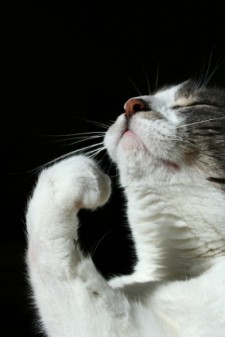Cats & Kittens

‘Thousands of years ago, cats were worshipped as gods. Cats have never forgotten this.’ - Anonymous
Feeding
Emergencies
Health
Vaccinations
Looking After Your Kitten/Cat
Rightly felt to be less demanding than dogs as far as training is concerned, cats enjoy the reputation of being clean and independent at the time of adoption. They seem to be the perfect pet: little bother, able to cope with periods of time alone and giving love and affection while respecting the independence of their master. But that should not prevent the owners from getting involved in their new friend´s up-bringing.
One of the first things to check is how far your kitten has got in terms of its socialisation. A very simple and useful test here is to (gently) take the kitten by the scruff of its neck and lift it up. A properly socialised kitten will respond to this kind of handling by curling up with its tail raised under its belly and a glassy look in its eyes. This is what is known as a ´positive carrying reflex´, and such a reaction indicates that the kitten has stayed with its mother long enough to be to be properly socialised.
If, on the other hand, the kitten begins to howl when you lift it up in this way, with its claws out and the whole body arched in hyper-extension, then its level of socialisation is very low. Patience and time will be needed to make a pleasant family pet of your kitten. If, after checking this reflex several times, you still decide to give a home to this kitten, do not hesitate to speak to your Vet, who will be able to advise you how to increase your new friend´s contact tolerance.
Attachment, socialisation, familiarisation
A cat´s entire capacity for socialisation depends upon the quality of the attachment it has formed with its mother, and on the degree of socialisation of the mother herself.
A cat develops much faster than a dog: where a dog takes about six months to become autonomous, the key period for a kitten to grow up into a well-balanced cat lies in the sixth week of life. Of course, all is not lost, and it is still possible to enhance socialisation at the usual age of adoption: i.e., around two months.
In the life of a cat, the first period of attachment is primordial, and this capacity for attachment, which is a juvenile characteristic, needs to be preserved. If this first attachment is of such a quality as to allow your cat to feel confident with all humans and other species (such as dogs) which it encounters, then it will be relaxed and happy to be with you. Otherwise, it will become familiar with just one or a small number of people, and hide away whenever a stranger appears; it will always be wary of the unknown, although your presence can reassure it.
If such a lack of socialisation is making your cat aggressive, do not hesitate to consult your Vet.
Training
During the period of development, the mother cat teaches her kittens certain "self-control mechanisms": i.e., how to regulate and co-ordinate their movements and the action of their teeth and claws.
A well brought-up kitten will always be careful with others´ faces, for example during games in which it is liable to scratch. If your kitten has not yet acquired this ability, you will need to teach it, and for this of course you will have to make use of behaviour patterns which it is familiar with.
If we observe a mother cat with her litter, we can see two means of correcting a kitten, and we can copy them with a little adaptation. Firstly, she paws the muzzle, claws retracted, when the kitten loses control. You can copy this by giving a fairly sharp tap on the muzzle with your finger to stop any unwanted behaviour, with no risk of hurting the kitten.
If the kitten is really turbulent, the mother sometimes grips it between her fore-paws and pounds its belly with her rear paws. Here again, if you lay the kitten down on its side and hold it there with one hand and scratch its belly with the other, you should succeed in inhibiting any movement.
It is important to understand that these two techniques are meant to teach self-control to the kitten and are not intended to achieve submission: in fact, the idea of submission and dominance does not apply in the everyday life of a cat.
Territory organisation
While cats may not always be social animals, they most certainly are always territorial. For your cat to be emotionally well-balanced, harmonious territorial structure is essential, and the feline approach to organisation is most particular and a far cry from human or even dogs´ ideas on the subject. Cats divide their territory up into a certain number of areas, each with its own specific function.
The isolation field is an area which the cat does not wish to share, unless it be with extremely familiar individuals, and then only when it so chooses. It is often a raised position, where the cat can feel perfectly safe. Activity fields may, on the other hand, be shared and are devoted to some particular occupation (bird-watching, hunting, playing or feeding, etc.).
These various fields are all inter-linked by pathways which are always the same, and which the cat traces with pheromone markers whenever it takes them. When you see a cat rubbing up against a piece of furniture, it is placing its familiarity markers there which will act as reassuring landmarks for it afterwards. This very strict and most particular organisation is necessary if a cat is to be emotionally well-balanced.
There are practical repercussions to this for you when you adopt a kitten. Right from the very first day, you should give it its isolation field: a place where no-one will come and disturb it when it is sleeping. The children and the dog of the household will quite naturally want to make contact with the new-comer; but, if your kitten is to develop peacefully, it has to have its own private place- which it may later decide to change. You should not systematically remove all the marks made by the cat rubbing itself against things in its new home. It is very important for it to be able to find its pheromones if it is not to develop a state of anxiety.
Uncleanliness and marking
Cats are toilet-trained from very early on, and one is often struck by the sight of a little kitten three weeks old struggling to get up into its cat-litter to relieve itself there. This reputation is well founded, and so it is all the more disappointing for a cat-owner to find that his or her cat is not clean. To avoid this, there are a few precautions to take. The elimination field should have certain features, and, however self-evident some of these may be, in practice experience shows that they are not always fully respected. The cat-box with the litter in it needs to be constantly accessible, including at night. Remember that cats were originally nocturnal animals. By living with humans, they may focus on daytime activity, but they still may well keep certain times during the night for specific occupations. The place you choose has to enable your cat to relieve itself without any problems.
If children are playing in the same room, or the dog is liable to come over and sniff the cat on its litter, then the conditions are not ideal and accidents may occur. The litter should be changed frequently.
Finally, do not confuse uncleanliness and marking.
Some cats use urinary marking, and the sequence here is highly characteristic. The cat stands up straight on its legs, rather than crouching down as it does to relieve itself, and sends shots of urine on to vertical supports. This is highly typical of a cat whose territory has been disrupted and who is failing to find its familiar landmarks. This can be due to changes in the household causing stress to the cat.
Ask one of our vets or nurses as treatment is available. We stock FELIWAY Pheromone therapy at our clinic our nurses will advise you how to use this to help combat spraying.
Playing and hunting
Cats at play like to mimic hunting. It is very important that you join in these games so as to check your kitten´s self-control mechanisms. It is by playing with you that it learns to control its biting and scratching behaviour.
Playing at hunting can involve balls, cat toys and any kind of mobile hanging on a string which moves in the slightest breeze. These create a rich environment and are vital to your kitten´s development.
A lack of stimuli and of imaginary prey can cause the animal to show aggression to the only mobile features to be found in its environment: your feet and hands! If you encounter this problem don’t hesitate to contact your vet.




